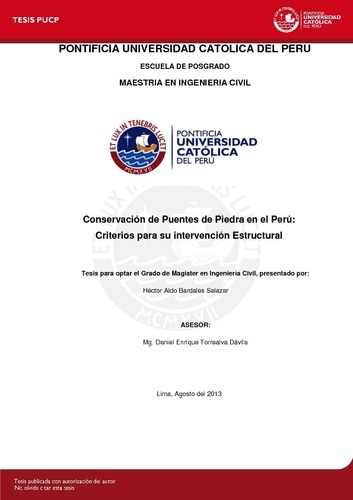| dc.contributor.advisor | Torrealva Dávila, Daniel Enrique | |
| dc.contributor.author | Bardales Salazar, Héctor Aldo | es_ES |
| dc.date.accessioned | 2014-04-22T21:53:43Z | es_ES |
| dc.date.available | 2014-04-22T21:53:43Z | es_ES |
| dc.date.created | 2013 | es_ES |
| dc.date.issued | 2014-04-22 | es_ES |
| dc.identifier.uri | http://hdl.handle.net/20.500.12404/5268 | |
| dc.description.abstract | Los puentes de mampostería de piedra o ladrillo forman una parte importante del
patrimonio arquitectónico del Perú. Aunque no muy numerosos su importancia radica en
que representan el estado del arte de la ingeniería de aquel entonces, los cuales en
muchos casos se siguen utilizando hasta nuestros días, como es el caso de varios
puentes ubicados en las ciudades de Lima, Arequipa, Huánuco, etc.
En el presente trabajo de Tesis se describe el proceso de evaluación estructural al
Puente Trujillo o Puente de Piedra, ubicado en el centro histórico de la ciudad de Lima y
construido a inicios del siglo XVII, con el fin de conocer su comportamiento estructural y
sugerir una adecuada intervención, así como promover una cultura de conservación.
La metodología expuesta a continuación nos muestra el desarrollo de la
evaluación estructural en base a las cartas internacionales en monumentos históricos, al
conocimiento histórico, la geometría, los materiales y la forma constructiva. Usando la
teoría de los elementos finitos se desarrolló un modelo tridimensional del puente,
aplicando al modelo un análisis estático lineal, un análisis modal, un análisis sísmico
estático y un análisis frente a una sobrecarga vehicular. Siendo esencial los dos primeros
análisis para obtener el comportamiento global de la estructura. | es_ES |
| dc.description.abstract | The bridges of stone or brick masonry are an important part of the architectural
heritage of Peru. Although they aren’t very numerous, its importance focuses in
representing the art’s state of engineering that time, which in many cases are still used to
this day, as is the case of several bridges located in the cities of Lima, Arequipa, Huánuco
etc.
This thesis’s work describes the structural evaluation process to Trujillo Bridge or
known as Stone Bridge, located in the historic center of the Lima city and built in the early
seventeenth century, in order to know its structural behavior and suggest an appropriate
intervention, so as promote an education of conservation.
The methodology described to following shows us the development of the
structural evaluation based on international charters of historical monuments, historical
knowledge, geometry, materials and type of construction. The finite element theory was
used for development a three dimensional model from the bridge, applying to model a
linear static analysis, a modal analysis, a seismic static analysis and a vehicular overload
analysis. The first two analyzes are essential for getting the global behavior of the
structure. | es_ES |
| dc.description.uri | Tesis | es_ES |
| dc.language.iso | spa | es_ES |
| dc.publisher | Pontificia Universidad Católica del Perú | es_ES |
| dc.rights | info:eu-repo/semantics/openAccess | es_ES |
| dc.rights.uri | http://creativecommons.org/licenses/by-nc-nd/2.5/pe/ | * |
| dc.subject | Mampostería | es_ES |
| dc.subject | Puentes--Diseño y construcción--Perú | es_ES |
| dc.subject | Diseño de estructuras | es_ES |
| dc.title | Conservación de puentes de piedra en el Perú: criterios para su intervención estructural | es_ES |
| dc.type | info:eu-repo/semantics/masterThesis | es_ES |
| thesis.degree.name | Maestro en Ingeniería Civil | es_ES |
| thesis.degree.level | Maestría | es_ES |
| thesis.degree.grantor | Pontificia Universidad Católica del Perú. Escuela de Posgrado | es_ES |
| thesis.degree.discipline | Ingeniería Civil | es_ES |
| renati.advisor.dni | 07927040 | |
| renati.discipline | 732267 | es_ES |
| renati.level | https://purl.org/pe-repo/renati/level#maestro | es_ES |
| renati.type | http://purl.org/pe-repo/renati/type#tesis | es_ES |
| dc.publisher.country | PE | es_ES |
| dc.subject.ocde | https://purl.org/pe-repo/ocde/ford#2.01.01 | es_ES |






